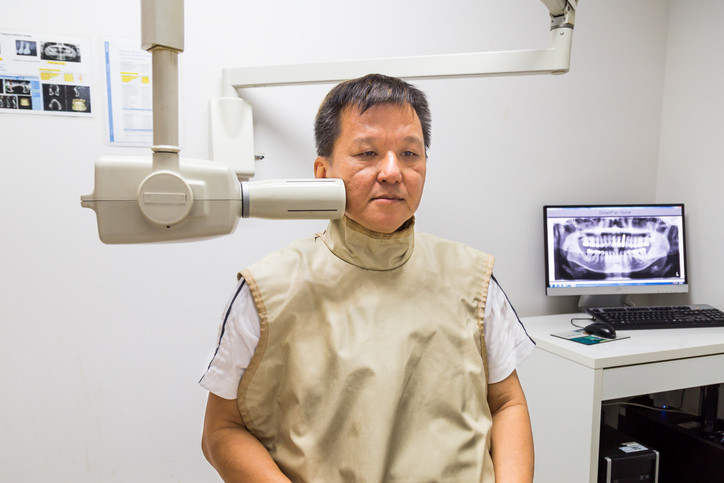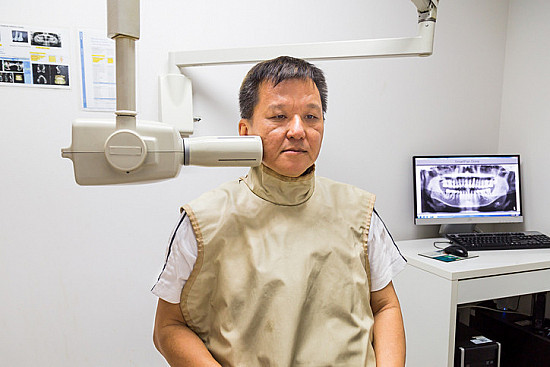[ad_1]

During a dentist appointment last month, I spotted a lead vest hanging unassumingly on the exam room wall as soon as I arrived. “Still there, but now obsolete,” I thought.
I had just learned new guidelines of the American Dental Association (ADA) stating that lead vests and thyroid collars that cover the neck are no longer necessary during dental x-rays. But they had been an integral part of my dental experiences – including numerous cavities, four root canals, a tooth extraction and two crowns – my entire life. What has changed and would I feel safe without the vest?
Why were lead vests used in recent years?
Over the years, countless Americans have worn lead vests and thyroid collars during dental x-rays. They have been in use for much longer than my lifetime – approx. 100 years. The heavy apron-like shields are placed over sensitive areas, including the chest and neck, before x-rays are taken.
“I haven’t worn a lead apron in the last 10 or 15 years – unless a dentist insists I wear it – because I know it’s not necessary,” says Dr. Bernard Friedland, associate professor of oral medicine and infection. , and immunity at the Harvard School of Dental Medicine.
What has changed in dental x-rays?
When lead vests and thyroid collars were first recommended, x-ray technology was much less accurate. But technology has evolved significantly in recent decades, significantly improving patient safety:
- Digital X-rays allow much lower doses of radiation, thereby reducing radiation exposure and the risks associated with higher doses, such as cancer. “The doses used in dental radiology are now negligible. If you go to the dentist today for a full series of mouth x-rays taken with a digital sensor, the total exposure time is just over five seconds “, explains Dr. Friedland, expert in oral radiology. “A hundred years ago, this exposure time would have been several minutes.”
- The small size The current X-ray beam significantly reduces the “scatter” of the radiation and limits the beam size to only the area to be imaged. This protects patients from radiation exposure to other parts of the body.
A less recognized barrier to the use of lead vests and thyroid collars is their ability to cause discomfort. They can block the primary x-ray beam, preventing dentists from capturing the necessary images. This quirk can lead to repeated images and unnecessary exposure to additional radiation. This is more likely to occur with panoramic x-rays.
Equipment can also spread germs, notes Dr. Friedland. Although disinfected, it is not sterilized between uses. “There is a risk of spreading bacteria and viruses,” he says. “For me, that’s also a problem and another reason why I don’t want to use one on myself.”
Who doesn’t need shields anymore?
No one does this, even children, who likely have a lifetime of dental x-rays ahead of them. The new recommendations apply to all patients, regardless of age, medical condition or pregnancy, the ADA says.
The recommendation to abandon lead vests was developed a long time ago. In fact, the ADA is not the first professional organization to propose this. THE American Association of Physicists in Medicine did so in 2019, followed by the American College of Radiology in 2021 and the American Academy of Oral and Maxillofacial Radiology in 2023.
Are some people confused or concerned about the no lead vest policy?
Yes. The new guidelines are sure to cause confusion and fear, Dr. Friedland says. Some people may even insist on continuing to wear a lead vest during x-rays.
“A big problem is that people’s perception of risk is very skewed,” he says. “Some people, you will never be able to convince them.”
People will likely feel more comfortable if this practice is uniformly adopted by dentists. However, the ability to implement this change may depend in part on public response. And full adoption could take some time.
“I think the public will have more say than dentists,” Dr. Friedland says. “It may take a generation to make this change, perhaps more.”
Still concerned about the new recommendations?
If you have any lingering concerns about the new recommendations, talk to your dentist.
And ask if dental x-rays are necessary to proceed with your diagnosis or treatment plan. Sometimes it is possible to take fewer x-rays – such as bitewing x-rays of the upper and lower back teeth only – or use certain types of imaging less frequently. Even under much safer x-ray conditions, dentists should be able to justify that the information in the images is integral to diagnosing problems or improving care, Dr. Friedland says.
It should be noted that the radiation dose, although much lower than in the past, varies depending on the type of imaging and which parts of the jaw are photographed. For example, the digital dental x-rays mentioned above involve less radiation than conventional dental x-rays. Either panoramic dental x-rays or 3D dental x-rays taken with a CBCT system which revolves around the head, generally involves more radiation than conventional dental x-rays.
Whenever possible, dentists should use images taken during previous dental exams, according to the ADA. “If I don’t need an X-ray, I don’t have one,” says Dr. Friedland. “I’m not cavalier about this. I also use technical parameters that keep the X-ray dose as low as reasonably possible.”
[ad_2]
Source link
